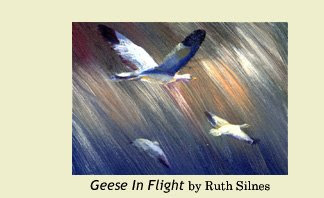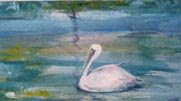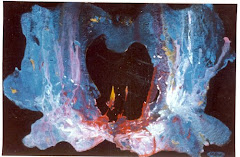I taught oil painting at the San Mateo County Arts Council and taught drawing in my studio at the Twin Pines Art Center, in Belmont CA.(now called 1870 Art Center.) My work is in the permanent collection of the Peninsula Museum of Art.
~~~
Leonardo Da Vinci wrote, “The feeling is what guides you to reach out for the knowledge.”
Start drawing something simple; such as a cup, a box or an apple.
 If your eye level is above the vase; the top will look oval. You will see all around the top of it and the bottom of the vase will arch down. If you are looking up at the vase the top will arch up and the bottom of the vase will look straight.
If your eye level is above the vase; the top will look oval. You will see all around the top of it and the bottom of the vase will arch down. If you are looking up at the vase the top will arch up and the bottom of the vase will look straight.
Shine a bright light on it from one side. Squint your eyes and study the shadows; notice the darkest is next to the lightest followed by the medium values; and lightly draw their shapes with your pencil.
When you are satisfied with what you have drawn; fill in darkest value first and gradually work in the lighter values. The shadows will be on the opposite side of where the light shines
Next draw a bowl of fruit, or a vase of flowers. Start by making light guidelines. To match both sides of the vase you can hold a ruler perpendicular in front of it.
If you want to draw flowers don’t sweat it, they don’t have to be accurate.
Outline the whole shape if you have a grouping of objects for a still-life. Within the outline draw a preliminary sketch of the objects. After you have done that go into the detail. To measure one object against another, squint your eyes. While keeping your arm parallel to the floor hold a pencil perpendicular.
To measure one object against another, squint your eyes. While keeping your arm parallel to the floor hold a pencil perpendicular.
While you are drawing, move away from your drawing from time to time to look at it from a distance and you will see the drawing better. Some artists like to view their work in a mirror.
Have a good time. Don’t be timid about your work. It is good to be fairly accurate and be bold, throw lines on the paper. In time, with concentration you will create wonderful drawings.
If you don’t feel the light is bright enough on your drawing you can use white chalk to brighten the part where the light is the strongest.
As a caution at this time I recommend you don’t show your work to family members or anyone who is not an artist. It is too easy to become disheartened. I learned that by experience.
There are famous artists who have been told after a couple of weeks to “give up art.” So don’t be discouraged over your first hundred drawings.
Always carry a small drawing pad and pencil with you to make sketches of  something or someone you see. There will be times when you will be waiting for a late friend, or in a doctor’s office, or waiting at the airport. The wait won’t seem so long.
something or someone you see. There will be times when you will be waiting for a late friend, or in a doctor’s office, or waiting at the airport. The wait won’t seem so long.
On an all purpose pad about 5”x 8” while waiting in the car for a friend I used the time to draw the scene that I saw from the car window.
Act ~ Risk ~ Do!
As an exercise, study paintings by famous artists. Copy or trace shadows from a master painter’s painting and the picture will show itself. Here's a Rembrandt tracing:
 Happy drawing. Before going to the next lesson work on these exercises for at least five hours
Happy drawing. Before going to the next lesson work on these exercises for at least five hoursLet me hear from you if you have questions or comments.












No comments:
Post a Comment